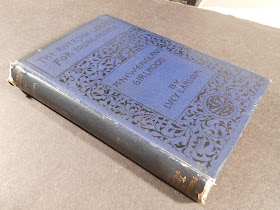 Forget the proverb – a book’s cover can teach us quite a bit, especially when its appearance illuminates deeper discussions in the text. Such is the case with the first edition of A New England Girlhood, an autobiography by American poet Lucy Larcom. Published in 1889, the volume physically embodies the themes of individuality and intimacy explored in the narrative.
Forget the proverb – a book’s cover can teach us quite a bit, especially when its appearance illuminates deeper discussions in the text. Such is the case with the first edition of A New England Girlhood, an autobiography by American poet Lucy Larcom. Published in 1889, the volume physically embodies the themes of individuality and intimacy explored in the narrative.Larcom was commissioned to write her autobiography for a series called The Riverside Library for Young People. The cover of A New England Girlhood notably markets the series as prominently as the text itself - the series name is stamped in large lettering across the top, while the book’s title and Larcom’s name are centered in the middle, in slightly smaller lettering. The spine and title page follow suit. This distinctive feature characterizes the relationship between text and series. A New England Girlhood both builds and is built by the Riverside series. It does not stand alone, but must be understood as part of a whole. This relationship dynamic extends from the text itself. Larcom’s narrative revolves around exploring the importance of context in individual development. She defines an autobiography as “a picture of the outer and inner universe photographed upon one little life’s consciousness.” The influences of people, places, literature, and nature collectively shape her existence. Larcom also understands her individual significance in terms of her membership in various communities, such as her family, workplace, literary societies, and God’s universe. Like the relationship between text and series, her individual life both constructs and is a construction of her surroundings.
![Image of the typographic title page reading "A New England Girldhoo/Outlined from Memory/By/Lucy Larcom/[Printer's mark]/Boston and New York/Houghton, Mifflin and Company/The Riverside Press, Cambridge/1889](https://blogger.googleusercontent.com/img/b/R29vZ2xl/AVvXsEj8eT-dH44A0JWIud6ehaoY2Btqfy2B6ElKyPJMDQVEfe6W5rAdYIUnGToelMZvHcziypR2BeAMYzAaBRgEKy-tqsPpSevwIZ6cL9UWPdTaJ9CZ9AExd5j0WSbw3Phf9KrS6weFvG_UUmY/s320/DSCN0773.jpg) This dynamic creates a thematic emphasis on relationships that is mirrored by the volume’s unassuming size. Its compactness and ability to fit comfortably in the reader’s hands imbue it with a sense of intimacy. The size also implies humility in its appeal to readers, as if the book is designed to resonate with individuals rather than attract a worldwide audience. Larcom, in fact, actively limits her audience, specifying that her story is for girls, women, and those who appreciate them, and that “all others are eavesdroppers, and, of course, have no right to criticize.” In doing so, she carves out an intimate space for an audience that in her time was rarely prioritized: young women. Here, the silenced and ignored narratives of women thrive. It is a space of expansive confinement - the closer its quarters, the greater the opportunity for empathetic story sharing. The volume’s physical dimensions contain and activate this intimate space.
This dynamic creates a thematic emphasis on relationships that is mirrored by the volume’s unassuming size. Its compactness and ability to fit comfortably in the reader’s hands imbue it with a sense of intimacy. The size also implies humility in its appeal to readers, as if the book is designed to resonate with individuals rather than attract a worldwide audience. Larcom, in fact, actively limits her audience, specifying that her story is for girls, women, and those who appreciate them, and that “all others are eavesdroppers, and, of course, have no right to criticize.” In doing so, she carves out an intimate space for an audience that in her time was rarely prioritized: young women. Here, the silenced and ignored narratives of women thrive. It is a space of expansive confinement - the closer its quarters, the greater the opportunity for empathetic story sharing. The volume’s physical dimensions contain and activate this intimate space.Object and text thus form a coherent package, tied together by these thematic-aesthetic parallels. But it is not enough to simply observe the parallels. Following Larcom’s philosophy, their significance cannot be understood without context. A New England Girlhood was written about female experiences, by a female author, in a patriarchal society that systematically silenced female voices. This context limited the range of choices available to Larcom, constricting the autobiography both internally and externally. Examining the thematic-aesthetic parallels suggests that each is a manifestation of this constriction. For example, Larcom’s narrative may have been published and marketed as part of a series because it was not considered ubiquitous enough to stand on its own. The volume’s small size may have resulted from the publisher’s assumption that the book would only attract a humble, self-selecting audience. Larcom’s thematic focuses likely originated from similar constraints. In her time, women were confined to the private sphere. Her emphasis on intimacy and privacy suggests her internalization of this confinement. Larcom also expresses a discomfort with the concept of autobiography – “I do not know that I altogether approve of autobiography myself” – revealing her uncertainty that her individual story is worth documenting. Her humble and relational attitude towards her life may reflect how societal concepts of female versus male individuality were disproportionately invested in relationships and family.
This analysis suggests that oppressive forces may have played a role in molding A New England Girlhood, both externally and internally. Yet this is not meant to discredit Larcom’s agency as a writer or the integrity of the themes she explores. Within the confines of a society that silenced her, Larcom found a space for her voice, strong and critical and true to her experience, if not completely unfettered. Understanding this allows readers to truly understand the threads of individuality and intimacy tying together text and object - not as face-value parallels, but as the productive interplay of tensions between constriction and resistance.
To see the book, ask for White Mountains PS2223.A3 1889a.
Posted for Elizabeth Klein '17
No comments:
Post a Comment